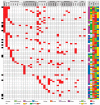High Constitutive Cytokine Release by Primary Human Acute Myeloid Leukemia Cells Is Associated with a Specific Intercellular Communication Phenotype
- PMID: 31277464
- PMCID: PMC6678419
- DOI: 10.3390/jcm8070970
High Constitutive Cytokine Release by Primary Human Acute Myeloid Leukemia Cells Is Associated with a Specific Intercellular Communication Phenotype
Abstract
Acute myeloid leukemia (AML) is a heterogeneous disease, and this heterogeneity includes the capacity of constitutive release of extracellular soluble mediators by AML cells. We investigated whether this capacity is associated with molecular genetic abnormalities, and we compared the proteomic profiles of AML cells with high and low release. AML cells were derived from 71 consecutive patients that showed an expected frequency of cytogenetic and molecular genetic abnormalities. The constitutive extracellular release of 34 soluble mediators (CCL and CXCL chemokines, interleukins, proteases, and protease regulators) was investigated for an unselected subset of 62 patients, and they could be classified into high/intermediate/low release subsets based on their general capacity of constitutive secretion. FLT3-ITD was more frequent among patients with high constitutive mediator release, but our present study showed no additional associations between the capacity of constitutive release and 53 other molecular genetic abnormalities. We compared the proteomic profiles of two contrasting patient subsets showing either generally high or low constitutive release. A network analysis among cells with high release levels demonstrated high expression of intracellular proteins interacting with integrins, RAC1, and SYK signaling. In contrast, cells with low release showed high expression of several transcriptional regulators. We conclude that AML cell capacity of constitutive mediator release is characterized by different expression of potential intracellular therapeutic targets.
Keywords: RAC1; SYK; acute myeloid leukemia; cytokines; differentiation; gene mutations; integrin; proteomic profile.
Conflict of interest statement
The authors declare no conflict of interest.
Figures





Similar articles
-
Proteomic Profiling of Primary Human Acute Myeloid Leukemia Cells Does Not Reflect Their Constitutive Release of Soluble Mediators.Proteomes. 2018 Dec 20;7(1):1. doi: 10.3390/proteomes7010001. Proteomes. 2018. PMID: 30577422 Free PMC article.
-
Two acute myeloid leukemia patient subsets are identified based on the constitutive PI3K-Akt-mTOR signaling of their leukemic cells; a functional, proteomic, and transcriptomic comparison.Expert Opin Ther Targets. 2018 Jul;22(7):639-653. doi: 10.1080/14728222.2018.1487401. Epub 2018 Jun 22. Expert Opin Ther Targets. 2018. PMID: 29889583
-
Patients with acute myeloid leukemia can be subclassified based on the constitutive cytokine release of the leukemic cells; the possible clinical relevance and the importance of cellular iron metabolism.Expert Opin Ther Targets. 2017 Apr;21(4):357-369. doi: 10.1080/14728222.2017.1300255. Epub 2017 Mar 3. Expert Opin Ther Targets. 2017. PMID: 28281897
-
The Possible Importance of β3 Integrins for Leukemogenesis and Chemoresistance in Acute Myeloid Leukemia.Int J Mol Sci. 2018 Jan 15;19(1):251. doi: 10.3390/ijms19010251. Int J Mol Sci. 2018. PMID: 29342970 Free PMC article. Review.
-
The chemokine network in acute myelogenous leukemia: molecular mechanisms involved in leukemogenesis and therapeutic implications.Curr Top Microbiol Immunol. 2010;341:149-72. doi: 10.1007/82_2010_25. Curr Top Microbiol Immunol. 2010. PMID: 20376612 Review.
Cited by
-
Acute Myeloid Leukemia: Is It T Time?Cancers (Basel). 2021 May 14;13(10):2385. doi: 10.3390/cancers13102385. Cancers (Basel). 2021. PMID: 34069204 Free PMC article. Review.
-
The Constitutive Extracellular Protein Release by Acute Myeloid Leukemia Cells-A Proteomic Study of Patient Heterogeneity and Its Modulation by Mesenchymal Stromal Cells.Cancers (Basel). 2021 Mar 25;13(7):1509. doi: 10.3390/cancers13071509. Cancers (Basel). 2021. PMID: 33806032 Free PMC article.
-
The Extracellular Bone Marrow Microenvironment-A Proteomic Comparison of Constitutive Protein Release by In Vitro Cultured Osteoblasts and Mesenchymal Stem Cells.Cancers (Basel). 2020 Dec 28;13(1):62. doi: 10.3390/cancers13010062. Cancers (Basel). 2020. PMID: 33379263 Free PMC article.
-
Proteome and Phosphoproteome Changes Associated with Prognosis in Acute Myeloid Leukemia.Cancers (Basel). 2020 Mar 17;12(3):709. doi: 10.3390/cancers12030709. Cancers (Basel). 2020. PMID: 32192169 Free PMC article.
-
Wnt Signalling in Acute Myeloid Leukaemia.Cells. 2019 Nov 7;8(11):1403. doi: 10.3390/cells8111403. Cells. 2019. PMID: 31703382 Free PMC article. Review.
References
-
- Döhner H., Weisdorf D.J., Bloomfield C.D. Acute myeloid leukemia. N. Engl. J. Med. 2015;373:1136–1152. - PubMed
-
- Arber D.A., Orazi A., Hasserjian R., Thiele J., Borowitz M.J., Le Beau M.M., Bloomfield C.D., Cazzola M., Vardiman J.W. The 2016 revision to the world health organization classification of myeloid neoplasms and acute leukemia. Blood. 2016;127:2391–2405. - PubMed
-
- Schlenk R.F., Dohner K., Krauter J., Frohling S., Corbacioglu A., Bullinger L., Habdank M., Spath D., Morgan M., Benner A., et al. Mutations and treatment outcome in cytogenetically normal acute myeloid leukemia. N. Engl. J. Med. 2008;358:1909–1918. - PubMed
-
- Valk P.J., Verhaak R.G., Beijen M.A., Erpelinck C.A., Barjesteh van Waalwijk van Doorn-Khosrovani S., Boer J.M., Beverloo H.B., Moorhouse M.J., van der Spek P.J., Lowenberg B., et al. Prognostically useful gene-expression profiles in acute myeloid leukemia. N. Engl. J. Med. 2004;350:1617–1628. - PubMed
Grants and funding
LinkOut - more resources
Full Text Sources
Research Materials
Miscellaneous

